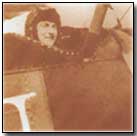Who's Who - Henry Botterell
 Henry John Lawrence
Botterell (1896-2003), while not qualifying as an
air ace -
he had one accredited 'kill' whereas he required five to gain official recognition -
gained celebrity in his final years as the sole surviving First World War
fighter pilot of any nation. When he died in early January 2003 there were none
left.
Henry John Lawrence
Botterell (1896-2003), while not qualifying as an
air ace -
he had one accredited 'kill' whereas he required five to gain official recognition -
gained celebrity in his final years as the sole surviving First World War
fighter pilot of any nation. When he died in early January 2003 there were none
left.
Botterell was born on 7 November 1896 in Ottawa, Ontario the son of a civil servant; in the years immediately prior to the outbreak of war in Europe he worked with the Bank of North America (today the Bank of Montreal). In 1916 he successfully applied to be a civilian flying trainee and was consequently despatched to England for relevant training. At around this time his older brother was killed in action while serving with the Toronto 48th Highlanders in France.
On 16 May 1917, then aged 20, Botterell (referred to as "Nap" on account of his apparent likeness to Napoleon) enlisted with the Royal Naval Air Service (RNAS) in the capacity of Probationary Flight Officer. His early flight experiences - with No. 8 Naval Squadron - were hardly encouraging: on only his second flight with the RNAS on 18 September 1917 he crash-landed his Sopwith Pup at Dunkirk shortly after take-off, sustaining multiple injuries. A six month spell of recuperation in hospital was followed by a medical discharge from the RNAS.
En-route to Canada for repatriation Botterell ran into a number of his former No. 8 Naval Squadron colleagues in London in the spring of 1918 who in turn arranged for Botterell to be sent to Manston in Kent in order to re-qualify as a pilot. 10 hours of refresher training later Botterell was approved to start flying once more and was promptly despatched to Serny on the Western Front where he rejoined No. 8 Naval Squadron, renamed in his absence 208 Squadron (attached to the RAF).
While serving in France at this time - in the immediate aftermath of great German spring advance - Botterell flew a variety of missions in different aircraft, including patrols and artillery spotting, flying a frenetic 91 sorties in just 60 days in his Sopwith Camel between June and August 1918.
Botterell's sole air victory saw him bring down a German observation balloon - well-defended by anti-aircraft guns - on 29 August near Arras.
After the armistice (by then a Flight Lieutenant), and following a further year with the RAF, Botterell returned to Canada - in the process arranging to smuggle, in three separate parts, the 9ft propeller of his Snipe aircraft.
Botterell returned to his work at the Bank of Montreal as Assistant Chief Accountant, initially in Quebec and then in Montreal, eventually retiring in 1970. He married in 1929, to Maud Goater, who died in 1983; they had two children.
With the advent of the Second World War Botterell served once more, this time in command of an air cadet squadron at Lachine in Quebec.
His interests included the violin, singing (he was a tenor), lone sailing, skiing, swimming and cycling.
In 1999 Botterell, then aged 102, was guest of honour at a dinner to celebrate the 75th anniversary of the Royal Canadian Air Force; the year previous he had celebrated his 102nd birthday at a hotel in Lille where he and 16 other Canadian veterans marked the 80th anniversary of the war's end; and in 2001 he received a visit from members of the present day 208 Squadron (based in Anglesey).
He died on 3 January 2003 aged 106.
Shrapnel comprised steel balls ejected from shells upon detonation.
- Did you know?
